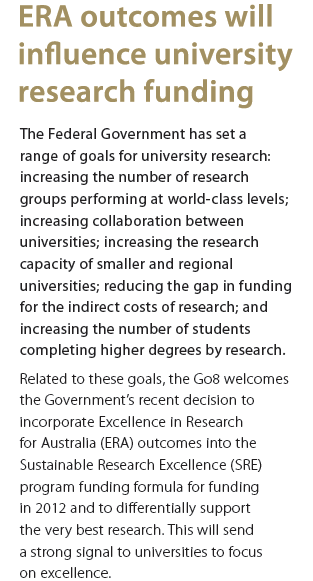|
|
|
|
|
|
|
News & Views item - March 2012 |
![]() The Go8 Gives Its Update on the ERA. (March 4, 2012)
The Go8 Gives Its Update on the ERA. (March 4, 2012)
Senator Kim Carr may have been excused from the Cabinet and the Department of Innovation, Industry, Science and Research may have been morphed into the Department of Industry, Innovation, Science, Research and Tertiary Education but the good senator's obsession, Excellence in Research for Australia (ERA) if not well, remains alive.
Now the Group of Eight in its March 2, 2012 newsletter leads off with its take as regards the utility of the ERA.
____________________________


____________________________
The federal government in the 2011 budget papers listed the overall cost of the ERA at $35 million and Australian Research Council CEO, Professor Margaret Shiel, in an interview with the Times Higher Education's Paul Jump in April last year justified the spending of $35 million as worthwhile.
However, Frank Larkins, Professor Emeritus in the School of Chemistry at the University of Melbourne and former Deputy Vice Chancellor at that university as well as Dean of Science and Dean of Land and Food Resources in 2010 and author of Higher Education Research Policies and Performance 1987-2010 (MUP 2011) back in August last year wrote a blog for the LH Martin Institute entitled 2010 Excellence in Research for Australia Exercise: What has been learned...
In his blog he notes: "The responsible minister, Senator Kim Carr, Minister for Innovation, Industry, Science and Research has described the ERA exercise as ‘a key element of the government’s agenda for the reform of Australia’s higher education system’. The cumulative cost of the 2010 exercise to all parties involved was at least $100 million for data collection, reporting and evaluation. A further evaluation exercise will be conducted in 2012 to refine the ERA methodology."
At the time TFW asked:
Well which is it [$35 million, $100+ million]?
And then the former deputy vice-chancellor lists four matters of particular pertinence with regard to the ERA:
What has been learnt by all parties from the 2010 exercise?
How should the information be used within universities to manage the diversity and quality of an institution’s future research profile and its impact on teaching programs?
How will the Federal Government use the ERA discipline quality information to allocate funding on a performance basis to universities in the future?
How should a university prepare for the 2012 exercise in view of the 2010 outcomes?
But for all the statistics and five charts Professor Larkins produces in his paper does it really matter?
The whole $100+ million exercise is geared to distribute research funding among university administrations using proxy methodology to determine the efficacy of past peer review by the ARC and NHMRC.
 Surely, if you are really interested in improving the research quality of the
university sector you should improve the processes of competitive-funding
assessment. And one of the most powerful tools to accomplish that is the full
utilisation of modern communications technology by the funding bodies in order
to improve the quality of those peers who review funding applications in
conjunction with the principle of funding the individual(s) undertaking the
research.
Surely, if you are really interested in improving the research quality of the
university sector you should improve the processes of competitive-funding
assessment. And one of the most powerful tools to accomplish that is the full
utilisation of modern communications technology by the funding bodies in order
to improve the quality of those peers who review funding applications in
conjunction with the principle of funding the individual(s) undertaking the
research.
Toni Scarpa has spent the last six years at the US National Institutes of Health (NIH) as its director of the Center for Scientific Review. In his view: "peer review is simple. I think it should ask only two questions. First: Is it worth doing? That is impact and significance. If the answer is yes, then you ask the second question: Can they do it? In the past we were asking those questions in reverse."
But it is vitally important to employ the best individuals to ask those questions and evaluate the answers.
Spending over $100 million on second guessing peer review through a rearward focusing ERA which will be used to determine the distribution of research funding through university administrations is not the way to do it.
And if we interpret the Go8 correctly and Professor Larkins is not far off the mark, at least $100 million has already been spent on a "product" of dubious value that will be used to allocate $65.7 million.
To quote Anna Russell when she précised Wagner's Ring Cycle: "I'm not making this up."